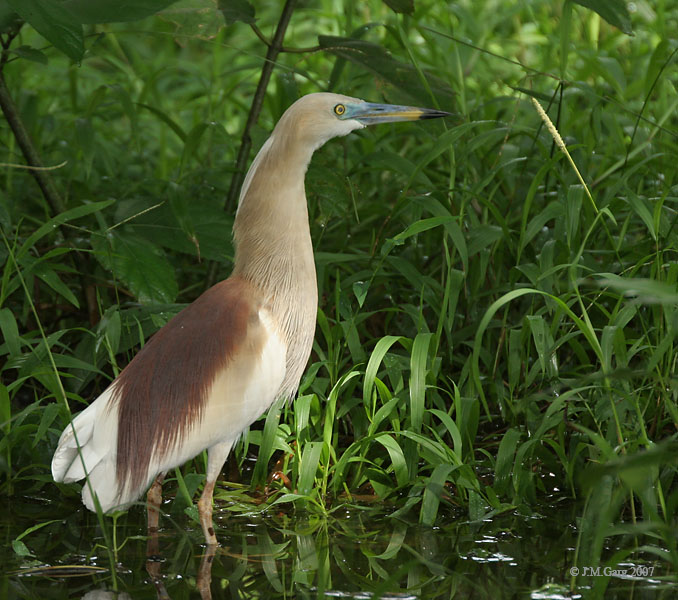- Indian Pond Heron
Taxobox
name = Indian Pond Heron
status = LC | status_system = IUCN3.1
status_ref = [IUCN2006|assessors=BirdLife International|year=2004|id=49590|title=Ardeola grayii|downloaded=12 May 2006]

image_caption = In non-breeding plumage (Kolkata ,India )

image2_caption =Breeding plumage in (Kolkata ,India )
regnum =Animal ia
phylum = Chordata
classis = Aves
ordo =Ciconiiformes
familia =Ardeidae
genus = "Ardeola "
species = "A. grayii"
binomial = "Ardeola grayii"
binomial_authority = (Sykes, 1832)
synonyms = "Ardeola leucoptera"The Indian Pond Heron ("Ardeola grayii") is a small
heron . It is ofOld World origins, breeding in southernIran and east toIndia ,Burma andSri Lanka .Description
They appear stocky with a short neck, short thick bill and buff-brown back. In summer, adults have long neck
feather s. Its appearance is transformed from their dull colours when they take to flight, when the white of the wings makes them very prominent. It is very similar to theSquacco Heron , "Ardeola ralloides", but is darker-backed. To the east of its range, it is replaced by theChinese Pond Heron , "Ardeola bacchus".During the breeding season, there are records of individuals with red legs. The numbers do not suggest that this is a normal change for adults during the breeding season and some have suggested the possibility of it being genetic variants. [cite journal|author=Gopisundar, K. S.|year=2004|title=Abundance and seasonality of Indian Pond Herons "Ardeola grayii" with red legs in Uttar Pradesh, India|journal=Forktail|volume=20|url=http://www.orientalbirdclub.org/publications/forktail/20pdfs/Sundar-PondHeron.pdf|format=PDF] [cite journal|author=Abdulali, H. and Alexander, H. G.|year=1952|title=Ardeidae with red legs|journal=Ibis|volume=94|pages=363] [cite journal|author=Wesley, H. D.|year=1993|title=Genetics of the red tarsi and feet in the Pond Heron|journal=Newsletter for Birdwatchers|volume=33|issue=4|pages=73] [cite journal|title=Distribution and extent of Pond Herons "Ardeola grayii" with red legs in India|author=Sundar, Gopi KS|journal=Indian Birds|volume=1|issue=5|pages=108-115|url=http://indianbirds.in/download/IB1.5Final.pdf|format=PDF]
Erythristic plumage has been noted. [cite journal|author=Parasharya,BM|year=1983|title=An erythristic pond heron|journal=Pavo|volume=21|issue=1&2|pages=107-108] The race "phillipsi" has been suggested for the populations found in the Maldives, however this is not always recognized.cite book|author=Rasmussen, PC & JC Anderton|year=2005|title=Birds of South Asia:The Ripley Guide|publisher=Smithsonian Institution & Lynx Edicions]
They are very silent but may give a harsh croak when flushed or near their nests.
This bird was first described by Colonel W. H. Sykes in 1832 and given its scientific name in honour of
John Edward Gray .Ecology
The Indian Pond Heron's feeding habitat is marshy wetlands. They usually feed at the edge of ponds but make extensive use of floating vegetation such as
Water hyacinth to access deeper water. They may also on occasion swim on water or fish from air. [Chandra-Bose,DA (1969) The Paddybird, "Ardeola grayii" (Sykes) floating on water. Pavo 7(1&2):74-75.] [Neelakantan,KK (1986) Pond heron afloat. Newsl. for Birdwatchers 26(5-6):11-13.] [Krishna, MB (1978) Pond Herons. Newsl. for Birdwatchers 18(10):10] They nest in small colonies, often with other wading birds, usually on platforms of sticks in trees or shrubs. 3-5 eggs are laid. [Pandey,Deep Narayan (1991) Nesting of the Pond Heron "Ardeola grayii" (Sykes) on Eucalyptus trees. J. Bombay Nat. Hist. Soc. 88(2):281.] These herons feed oninsect s (including dragonflies [cite journal|title=Indian pond-herons "Ardeola grayii" feeding on dragonflies|author=Santharam,V.|journal=Journal of Bombay Natural History Society|volume=100|issue=1|year=2003|pages=108] ),fish ("Barilius" noted as important in a study in Chandigarh) andamphibian s. [cite journal|title=Feeding ecology of Indian pond heron and its comparison with that of little egret.|author=Sodhi, NS|journal=Pavo|volume=24|issue=1&2|pages=97-112|year=1986]Nocturnal movements of Pond Herons have been noted along the coast near
Chennai . [cite journal|author=Santharam,V|year=1987|title=The Pond Heron - its local movements|journal=Newsl. for Birdwatchers|volume= 27|issue=9&10|pages=4-6]They are very common in India, and they can be approached very close before they are flushed. They may also forage at garbage heaps.
They have few predators and injured birds may be taken by birds of prey. [cite journal|author=Navarro,A|year=1962|title=Pale Harrier taking a Pond Heron|journal=J. Bombay Nat. Hist. Soc.|volume=59|issue=2|pages=653]
An arbovirus "Balagodu", trematodes and several other parasites have been isolated from the species. [cite journal|author=Pavri K, Sheikh BH, Singh KR, Rajagopalan PK, Casals J|year=1969|title=Balagodu virus, a new arbovirus isolated from "Ardeola grayii" (Sykes) in Mysore State, South India.|journal=Indian J Med Res.|volume=57|issue=4|pages=758-64] [cite journal|author=Pavri KM, Rajagopalan PK, Arnstein P|year=1968|title=Isolation of Ornithosis bedsoniae from paddy birds, "Ardeola grayii" (Sykes), in Mysore State India|journal=Indian J. Med. Res.|volume=56|issue=11|pages=1592-4] [cite journal|title=On a new trematode of the genus Psilorchis (Psilostomidae Looss, 1900) from pond heron "Ardeola grayii"|author=Sahay S; Sahay U; Verma DK|journal=Indian journal of parasitology|year=1990|volume=14|issue=2|pages=203-205] [cite journal|title=The life history of Echinochasmus bagulai Verma 1935 (Trematoda, Echinostomatidae).|author=Madhavi, R;Narasimha Rao, N;Rukmini, C|journal=Acta Parasitologica Polonica|volume=34|issue=3|pages=259-265|year=1989] [Cite journal|journal=Riv Parassitol.|year=1971|volume=32|issue=2|pages=101-3|title= On the male of "Avioserpens multipapillosa" Singh, 1949 from Ardeola grayii|author=Deshmukh PG] Antibodies to Japanese Encephalitis/West Nile Virus has been detected in Pond Herons and Cattle Egrets from southern India. [cite journal|journal=Indian J Med Res|volume=118|year=2003|pages=101-108|title=West Nile virus: the Indian scenario|author=R. Paramasivan, A.C. Mishra & D.T. Mourya|url=http://icmr.nic.in/ijmr/2003/0901.pdf|format=PDF] Heavy metal pollution appears to be indicated particularly in the tail feathers. [cite journal|journal=Bulletin of Environmental Contamination and Toxicology|year=2004|volume=73|issue=2|pages=285-291|author=Muralidharan, S., Jayakumar, R., Vishnu, G|title=Heavy metals in feathers of six species of birds in the district Nilgiris, India]
Karyology studies indicate that Pond Herons have 68 chromosomes (2N). [cite journal|author=M. K. Mohanty & S. P. Bhunya|journal=Genetica|title=Karyological studies in four species of ardeid birds (Ardeldae, Ciconiiformes)|volume=81|issue=3|pages=211-214|year=1990|doi=10.1007/BF00360867]
References
Gallery
Wikimedia Foundation. 2010.
